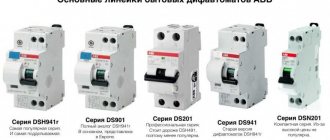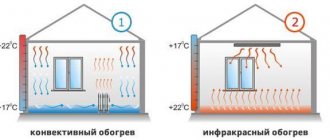When creating or reconstructing an intra-apartment or home electrical network, it is not enough to limit yourself only to laying wires (even of the required cross-section) and placing sockets and switches convenient for everyday use. Particular attention should always be paid to measures to ensure the safe operation of both the network itself and the household appliances connected to it. Sad statistics show that up to a quarter of all registered fires occur for reasons related to malfunction or imperfection of household electrical equipment. And incident reports continue to contain reports of tragic cases of people being injured by electric shock when using lighting fixtures or home appliances.
Which is better, difavtomat or RCD?
In order to protect both himself and his household, to ensure the safety of the home and all the property in it, the owner is simply obliged to provide for the installation of special protection devices. Nowadays, several varieties are offered - these are automatic circuit breakers, residual current devices (RCDs) and differential circuit breakers that have replaced fuses. And those who first tackled this problem often have a question: which is better, a difavtomat or an RCD? Let's try to answer it.
It is clear that taking on electrical installation yourself, without having the skills, is a gamble, and sometimes even very unsafe for life. But knowing such questions is useful for everyone, at least for reasons so that you can competently plan the “budget” for home network renovation. And it will be easier to communicate with an invited electrician, since many of these amateur craftsmen are big fans of “hanging noodles” on ignorant owners in order to rip off extra money.
And in order to be able to compare a differential circuit breaker with an RCD, it is probably necessary to have at least a little idea about their structure and functions.
Difavtomat or RCD - which is better?
And first of all, it is necessary to clarify: a differential circuit breaker is no better or worse than an RCD, and vice versa. The choice should be based on the specific tasks and conditions in which they will be used.
A clear example in this part will be that if a differential circuit breaker turns off all or part of the wiring in the event of an overload or short circuit, then the RCD will do the same, but in the event of a current leak. To put it simply, metering usually means insulation damage when current “leaks” into the ground, which is important when conductive elements hit the ground or anywhere else. This does not apply to the normal operation of the device and also poses a danger to people and their property. Ideally, it is recommended to install the devices together, as one complements the other.
As a result, the choice between the two systems, if you approach it too categorically, does not make any sense at all, since it is often impossible to predict the cause of the problem. However, if there is absolute confidence that a network overload is more likely to occur than a current leak, and vice versa, then choosing between an RCD and a differential circuit breaker makes sense.
Criterias of choice
Devices are selected according to their intended purpose:
- For sockets and electrical appliances - 10 and 30 mA.
- For lighting networks of wooden houses - fire protection (100, 300 and 500 mA).
When selecting an RCD based on sensitivity, you should keep in mind natural current leaks. In the network they are (mA):
- Iut=0.01*L, where L is the total length of wires, m;
- in the electrical receiver - Iut=0.4*L.
If the natural leakage is 150 mA, then a device of 100 (mA) or less will often falsely operate. Large networks are divided into groups.
The class of the device by the type of leakage current is chosen in accordance with the type of electrical receivers. It is irrational to install type A devices on all lines, since they are much more expensive than AC.
Devices are selected based on sensitivity.
Electromechanical RCDs are the most reliable. The amplification circuit in electronic analogues requires power. If the neutral above the device breaks, it is de-energized and the RCD becomes inoperable. At the same time, live parts remain energized, which means there is a risk of electric shock and fire.
It is recommended to purchase electronic models only as a last resort if there is little free space in the panel. For example, a voltage relay and a smart home system contactor are already installed on the DIN rail.
In terms of rated current, the device must be one step higher than the circuit breaker protecting it. It opens the circuit instantly only in the event of a short circuit, and at lower overloads the response time can reach 60 minutes. Throughout this period, a current higher than the rated current will flow through the RCD, which will lead to breakdown.
RCD feature
However, you need to understand that there are scenarios in which the RCD simply does not respond. These, for example, include cases of animals coming under voltage, when there is no short circuit to the ground. This scenario is quite possible when there is simultaneous contact with the phase and neutral conductors. In addition, this can also happen if there is insulation with the floor.
This feature is due to the fact that the RCD is simply not capable of distinguishing the current that passes through an animal or person from the one that is usually present in the load element. Here you can only use mechanical protection or de-energizing before direct contact, if such is planned. This problem is also partially solved by a plug-in circuit breaker, with which the RCD works in tandem, which provides protection against leaks and overloads, but more on that later.
Danger of current leakage
An RCD is needed to protect you from electrical leaks.
As a result of insulation failure, live parts may come into contact with metal casings of equipment or building structures.
This leads to undesirable consequences:
- Electrical injury to users.
- Fire.
In both cases, part of the charge leaves the circuit. This phenomenon is called current leakage.
Space Occupied
First, we note that, in principle, the issue of space should not arise in a proper electrical system. If there is not enough space for something, then the shield needs to be updated and everything that is needed installed. However, when we choose between an RCD and an RCD, we will also have to take into account one aspect of how an RCD differs - an additional module.
This is justified by the fact that the RCD completely lacks built-in overcurrent protection. The consequence of this is the mandatory installation of a circuit breaker that will protect it. As a result, it turns out that installing an RCD takes three modules.
If the main device is an automatic machine, then it will take up only two places. This difference is not too great, but often the installation of at least two or three modules is required, not counting their further increase. In such a strategic perspective, it is simply impossible to visually determine in advance how much space will be needed for each module. That is why you need to either save or expand space.
What mistakes should you avoid?
Before connecting, be sure to double-check the technical specifications of the devices. The rated current must be equal to or higher than the same parameter for the input circuit breaker. The values can be easily determined by the markings.
Electricians recommend choosing a protective device one step higher, that is, for a 50A circuit breaker, a 63A RCD is suitable.
You can correctly calculate the parameters, choose a machine and an RCD with the correct rating, but make a small mistake during installation, as a result of which the system will be useless.
For example, beginners often confuse tires. It should be remembered that I use different buses for the neutral conductor and the ground wire. In addition, each device requires a separate bus: for 5 RCDs - 5 buses.
Whatever connection scheme you use, the grounding conductor will not participate in it. All terminals are designed either for the phase wire (load) or for the zero wire (neutral)
In no case should the poles N and L be confused . They have letter designations on the body, and the wires differ in color, so you need to be careful.
If a false alarm occurs or, on the contrary, the device does not respond, the reason may be the following:
- “phase” and “ground” are connected after the RCD;
- incomplete connection - conductor N is not inserted into the corresponding terminal;
- “zero” and “ground” are connected in the socket;
- confusion between connecting two or more RCDs to electrical installations.
In practice, there are many more errors, since different schemes are used. The more devices are involved in assembling the electrical panel, the more careful you need to be when connecting.
Connection
Here it is worth mentioning the differences between connecting an ouzo and a machine with a difautomatic machine. This must be taken into account, if only because the connection speed determines not only the installation time, but also repair or replacement in case of problems.
So, the RCD is connected like this: the phase wire is connected to the circuit breaker, which comes out of it and is connected to the RCD terminal. After which the neutral wire is connected to the upper terminal, and the phase and zero move from the lower part to the consumer.
If we consider a difavtomat, then everything is much simpler: the wire - phase and neutral - is connected to the upper terminals, and from the lower ones everything immediately goes to the consumer. Thanks to this option, installation or replacement time can be significantly reduced.
Schemes for three-phase network
In a private house, a 380 V line can be installed. In industry, such networks are always installed.
General RCD for 3-phase network + meters
A four-pole protection device is used. On each side it has 3 phase contacts and 1 for neutral. The need to lay a neutral wire is due to the uneven distribution of the load along lines A, B and C. They are distributed around the house to connect 1-phase electrical receivers and only to the most powerful ones, designed for a voltage of 380 V, are all 3 connected at once.
Diagram of a common RCD for a 3-phase network.
The disadvantage of this solution is the use of a protection device with low sensitivity. This is due to large natural leaks.
General RCD for 3-phase network + group RCD
More expensive, but practical and safe scheme. The connection is made in the same way as in a similar version for a 1-phase network, only a larger number of wires are used. It is recommended to follow the color coding so as not to confuse lines A, B and C.
Group RCD diagram.
At the input, a selective-type device (with a delay response) of 4 poles is installed. On groups with symmetrical loads - 3-pole. They do not need a neutral conductor, since the currents in lines A, B and C cancel each other.
Reliability under failures
Now regarding technical behavior during a power outage. So, if the RCBO turns off, you will need to find the reason. There are three of them in total:
- leakage current;
- short circuit;
- overload.
A person who is familiar with the topic will need about an hour to determine the exact reason for the circuit breaker tripping and about the same amount to eliminate it. In the case of an RCD and an automatic device, everything is much simpler, since it has fewer protective functions. If it turns off, then the problem is a current leak - there simply cannot be any other options.
The differences from ouzo in this case are colossal. This especially applies to people who do not understand electrical engineering.
Step-by-step installation instructions
Self-installation is performed in the following order:
- Develop and draw a diagram. It is necessary to think over how to connect each core, so a simple single-line one is not suitable.
- The contacts of the input circuit breaker are opened. Work may only be carried out on a de-energized line. Make sure there is no voltage using an indicator screwdriver.
- The device is mounted on a DIN rail. To do this, use a screwdriver to bend the clamp on the back side.
- The ends of the cores are stripped by 0.5 cm and fixed in the RCD terminals. Color coding must be observed. Stranded conductors are pre-crimped with an NShVI type tip or tinned.
- The device is marked in a convenient way to understand which consumers are connected through it.
In electrical engineering, it is customary to place a connection diagram in the panel.
Installation of the RCD is carried out in a certain order.
Breakdowns and quality
Each device has a service life and nothing can be done about it. During operation, regardless of whether it is a difavtomatic machine or an ouzo, wear occurs. It is quite obvious that if it fails, it must be replaced immediately. However, when considering such aspects, something else is important, namely the consequences of failure.
Thus, if the automatic switch is broken, then most likely there will be a malfunction in the thermal release. This can lead to a shutdown or increased load, which will significantly deviate from the time delay parameters set by the manufacturer. There is only one way out of this situation - complete replacement of the device. The RCD differs in this regard, since when using it it is easier and cheaper to replace the specifically failed part.
If we talk about the quality and durability of each of the devices, which is especially important when the question arises of what is better to choose - an ouzo or a difavtomat, then the majority have an opinion about the unreliability of universal devices. This opinion is formed due to the firm conviction that a device that has a clear task performs it better than one that is “sprayed” into several aspects at once.
And if earlier one could agree with this, now manufacturers make such high-quality equipment that, regardless of the direction of operation of the device, they work the same. This is also confirmed by tests that clearly demonstrate an equal number of defects and premature failure of both types.
Only one thing can be said for sure - the build quality depends on the manufacturer. After all, it is they who determine what components and where the device will be assembled. If attention is not paid to this, then, regardless of the price and the parts used in it, you can end up with an unreliable device that will quickly fail.
How to determine the number of machines?
How many machines can be connected to one RCD? It depends on which machine you choose. The calculation of the quantity depends on the maximum permissible load current and disconnecting amperes.
The PUE states that the RCD/switch ratio is one to one or one to two.
In the standard case, the differential leakage current is 30 mA.
Therefore, one machine, depending on how many amperes it is designed for, can have 6A, 10A or 25A.
To maintain the load on the device, you can set:
- 1 pc – 25A;
- 2 pcs – 10A;
- 4 pcs - at 6A.
Another question often arises: how many sockets can be connected to one device?
Their number directly depends on what household appliances and appliances you will connect to them.
Any number of outlets can be connected to one device, provided that they do not simultaneously include an unacceptable number of electrical appliances.
As a rule, separate machines are installed on the washing machine and oven.
How many amperes should I set the breakers? For a socket group, 16A will be enough; for lighting, 10A options are suitable.
Financial aspect
And the main thing that distinguishes RCDs and RCBOs in cases of private use at home is cost. It demonstrates well what most users will prefer, especially if we consider the device from the point of view of reliability, which is the same among famous manufacturers.
And here's why price will ultimately become the main aspect when choosing:
- the complexity of the connection will cease to bother you over time, as you gain experience and the installation will no longer be something difficult and unknown;
- finding the reasons for the shutdown will also not become a problem over time, when you have to go through about five unforeseen situations;
- reliability and workmanship will be the main aspect, because it will speak about long-term operation more than anything.
And now, when we come to the cost, taking into account all the connections and purchasing a panel with enough space for everything, the difference in price will not even exceed 4,000 rubles. This is not such a large amount that is worth saving in electrical matters, since you can lose much more due to improper power supply.
The choice between an RCD and an RCD is really worth paying attention to, because the life of not only household appliances, but also people depends on electricity. Negligence and economy can lead to death or fire, which is not worth either one or the other.
Main technical characteristics
Each RCD has a certain set of technical parameters that should be studied before purchasing:
- manufacturer;
- model name;
- operating current - the maximum current value that the device can switch;
- power supply parameters (voltage and frequency);
- leakage current - the maximum value of leakage current to which the device responds;
- RCD type;
- operating temperature range;
- rated conditional short circuit current;
- RCD device diagram.











